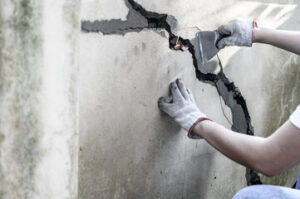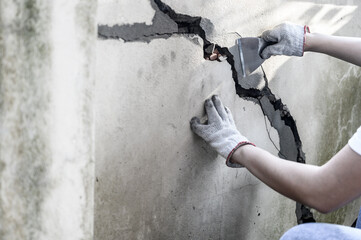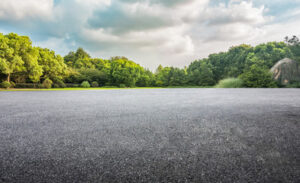Concrete Repair Colorado Springs can be repaired in a variety of ways. The repair method chosen will depend on the type and extent of damage.
The material used for repair must make an integral bond with the base concrete to prevent shrinkage cracking. It should also be low w/c and have a high percentage of coarse aggregate to minimize chloride ingress.

Many different methods can be used when repairing concrete. The best approach will depend on the crack’s severity and the concrete type. The surface of any crack you are repairing must be clean and dry before starting the repair process. This will help the concrete patch to adhere better and last longer.
One of the most common methods for repairing concrete cracks is routing and sealing. This involves enlarging the crack and filling it with sealants. The types of adhesives used can include silicones, epoxies, or urethanes. This method is most often used for dormant cracks, but it can also be used for active cracks if the correct type of filler is used.
This is a very cost-effective method of repairing concrete cracks. However, it is recommended for use on only a few wide cracks. A drill and cutting tool are required for this method. The drilled holes are then filled with a joint sealant. A good quality concrete supply is important to ensure you get the right sealant.
Another method of repairing cracks in concrete is by using a technique called stitching. This is done by drilling holes on both sides of the crack and placing large staple-looking metal units into these holes. These units are then anchored to the concrete with epoxy. This is a very effective method of repairing concrete cracks and can be used for active and dormant cracks.
In addition to these crack repair methods, there are several ways to prevent them from coming back in the future. Proper drainage systems are important to any driveway, sidewalk, or patio. This will reduce water levels, which will stop the cracks from growing. This will also keep moisture out of the cracks, preventing further damage to the concrete.
If you are repairing a cracked concrete section, using a product specifically designed for vertical and overhead concrete repairs is a good idea. These products have a thicker consistency and create a stronger bond on vertical surfaces. They can be sanded or painted for a more attractive finish.
The epoxy injection method offers a fast and straightforward repair solution for structural cracks. Although the procedure will vary depending on the structure, it generally involves prepping the concrete surface, installing injection ports, injecting, and removing the ports. The type of injection resin required varies by the size and depth of the crack and should be low in moisture content to prevent water entry that could cause further damage or even more cracking.
Before beginning, the crack must be cleaned. A high-pressure water jet or wire brush may remove dirt and debris from the surface of the crack and the concrete beneath. The crack should then be widened to create a V-shaped profile to aid in bonding with the epoxy. The crack in a concrete slab should also be restressed with an anchor bolt or metal strapping.
Surface ports, short rigid-plastic tubes with a flat base that serve as convenient entryways for the injection materials, are installed on the concrete surface adjacent to the crack. They can be spaced an inch apart for each inch of wall thickness or, as a rule of thumb, per inch of crack width. Sealboss 4500 crack-sealer epoxy paste is applied as a surface port adhesive and topped with a clean cap.
Injection begins at the lowest port and continues until epoxy begins to ooze out of the port above it, which is a visual indication that the crack is full to that point. Then, the first port is plugged, and the injection continues at the next port until the entire crack is filled.
The primary benefits of injection are that it effectively seals the crack to prevent harmful moisture from entering and monolithically welds the rebar together. While many believe that structural welding is the most important result of the repair, the sealing properties are often just as important. This is because the process protects the reinforcing from premature deterioration.
Hydraulic cement is an ideal solution for repairing holes and cracks in concrete structures. It can be used on various surfaces, including basement walls and floors, outdoor walkways, and swimming pools. It creates a watertight seal that keeps leaks from coming through the surface of the concrete. While hydraulic cement is a useful tool in the home, if you need to repair large areas of your foundation, you should contact a professional for a permanent solution.
This type of cement sets and hardens when mixed with water in a process called hydration. Most concrete structures we come into contact with are made with this type of cement. It is also possible to modify this material with additives to improve its performance, such as greatly reduced curing and setting time, the ability to be used underwater, or increased strength.
The basic hydraulic cement is a dry powder that mixes with water to become a liquid that forms and hardens the concrete structure. It can be used in many applications requiring strong, water-resistant concrete, such as filling cavities, making casts, or anchoring bolts and equipment. The hydration process is controlled by the temperature of the water, which allows for rapid application in situations where time is critical.
Various additives can be used to alter the properties of this material, such as modifying the water content for different climates or conditions or adding plasticizers that make it more flexible. Some types of hydraulic cement are designed for use in marine environments, where they can withstand moderate sulfate attack. Other versions are used to repair concrete structures exposed to high sulfate levels, such as bridges and dams.
It is important to prepare the surface by removing any loose debris or dust when using this material. It is also necessary to blend the material well, as it should have a heavy putty consistency. The best method is to mix it in a mechanical mixer, following the manufacturer’s recommendation for water content and the addition of additives.
Concrete bonding agents are adhesives used to help different concrete layers adhere. They are applied to the old concrete surface before patching or installing a new overlay or coating. This ensures that the new layer is bonded to the old one, which makes the entire structure stronger and more durable.
Before applying any bonding agent, the surface of the old concrete slab must be completely clean. This means brushing, vacuuming, or dusting away dirt, grime, or other debris on the old layer. In addition, the concrete should be pressure-cleaned to remove any grease or oil that may be present on the surface. Finally, any steel reinforcement that may be exposed on the surface of the old concrete should be protected with anti-corrosion slurry.
Many different types of bonding agents are available on the market, each with unique properties and uses. For example, cementitious bonding agents are great for concrete repair as they offer high strength and durability. On the other hand, acrylic latex bonding agents are ideal for fiddly jobs and work well with concrete surfaces like stucco or masonry.
Applying a concrete bonding agent must first be mixed with water according to the manufacturer’s instructions. This is important, as the consistency of the bonding agent will determine how effective it is. In addition, it is crucial to follow the drying time of the bonding agent, as failure to do so can result in a weak bond between the concrete and the new surface.
Once the bonding agent has been properly mixed, it can be applied to the old concrete surface using a brush or trowel. It should be applied liberally and evenly, covering the entire area receiving the new overlay or coating. Depending on the bonding agent chosen, it may take a few minutes and several hours to dry. Once it has dried, the new surface can be coated or laid as desired.



